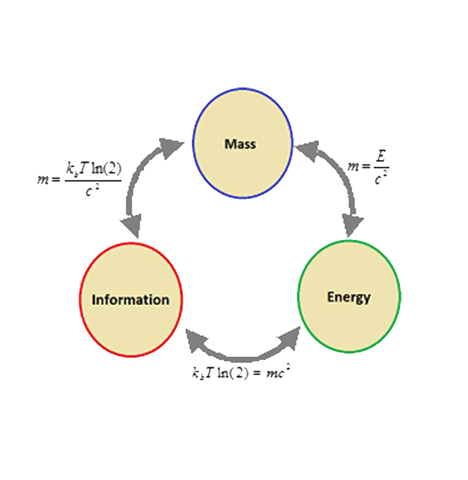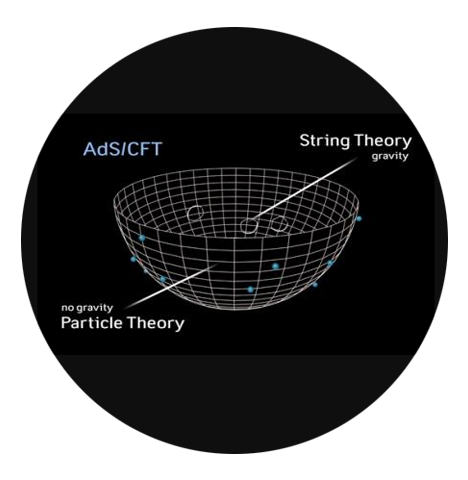Holographic Gravity
Center

Theoretical Presentation
The nature of gravity, entropy, and information is one of the most profound challenges in theoretical physics. The Scaling Entropy-Area Thermodynamics (SEAT) framework provides a unified approach that extends the holographic principle beyond the AdS/CFT correspondence, proposing that gravity is an emergent phenomenon from entangled information patterns encoded on boundary surfaces. This perspective is encapsulated in the Generalized Holographic Principle (GHP), which asserts that all physical processes within spacetime arise from quantum informational degrees of freedom. By integrating concepts such as black hole thermodynamics, entanglement entropy, and the mass of a bit of information, SEAT establishes a mathematical and physical foundation for Holographic Gravity (HG) and explains the entropy evolution of gravitational systems.
The Mass of a Bit of Information and Hidden Thermodynamics
The entropic information approach posits that information has a fundamental mass. This idea, derived from Vopson's mass-energy-information equivalence principle, allows entropy to be described in terms of fundamental information bits, leading to a new entropy formula based on the hidden thermodynamics of Louis de Broglie. This equation demonstrates that entropy can be quantized in terms of information bits, linking the thermodynamic properties of a system to its informational content. This equation incorporates Planck’s constant (h), Boltzmann’s constant (k), and temperature (T), reinforcing the connection between quantum mechanics, thermodynamics, and information theory.
Black Hole Thermodynamics and SEAT
The traditional understanding of black hole thermodynamics arises from the Bekenstein-Hawking entropy formula. This equation suggests that black hole entropy is not proportional to volume but rather to surface area, an insight that has led to the development of the holographic principle.
SEAT extends this concept by demonstrating that entropy evolution is dynamically governed by gravitational interactions.
Using the surface gravity (κ), the entropy equation derived from SEAT is:
S= k κMA/ℏc
which suggests that black hole entropy depends not only on the area of the event horizon but also on mass and surface gravity. This formulation allows entropy to be understood as a dynamic process, evolving through interactions with quantum fields and thermodynamic principles.


Black Hole Information Paradox and SEAT’s Resolution
The black hole information paradox arises from the apparent loss of information during Hawking radiation. SEAT addresses this paradox by showing that black holes do not simply radiate thermal entropy but instead emit structured, entangled information. The entropy of the emitted radiation matches the entropy of the black hole, ensuring information conservation.
By computing the entropy of entangled Hawking radiation using the fine-grained entropy formalism, SEAT confirms that the entropy of a black hole is equal to that of its radiation.This conclusion aligns with the von Neumann entropy, the Bekenstein bound, and the Ryu-Takayanagi formula, demonstrating that information is encoded and preserved within entanglement structures at the event horizon.
The Ryu-Takayanagi Formula and Entanglement Entropy
The Ryu-Takayanagi formula further strengthens SEAT’s foundations by linking spacetime geometry to entanglement entropy. In the context of AdS/CFT, the entanglement entropy of a boundary region in a conformal field theory (CFT) corresponds to the minimal surface area in the bulk AdS space:
SEAT generalizes this relationship beyond AdS spacetime, suggesting that gravitational entropy emerges from quantum entanglement in all spacetimes, not just those with conformal boundaries. This leads to the assertion that spacetime itself is a product of structured information, with gravity emerging from entanglement.
Holographic Gravity (HG) and the Generalized Holographic Principle (GHP)
Holographic Gravity (HG) proposes that gravitational effects are not fundamental but rather emergent from microscopic degrees of freedom encoded on lower-dimensional boundary surfaces. This idea extends the holographic principle to all gravitational systems, suggesting that quantum entanglement patterns dictate the structure of spacetime.
The Generalized Holographic Principle (GHP) encapsulates this view, positing that:
• Gravity is an emergent phenomenon arising from the quantum informational structure at boundaries.
• Spacetime curvature results from entanglement density rather than traditional mass-energy distributions.
• Black holes and other gravitational systems obey an extended entropy-area relationship, where entropy is proportional to the area of encoded information.
